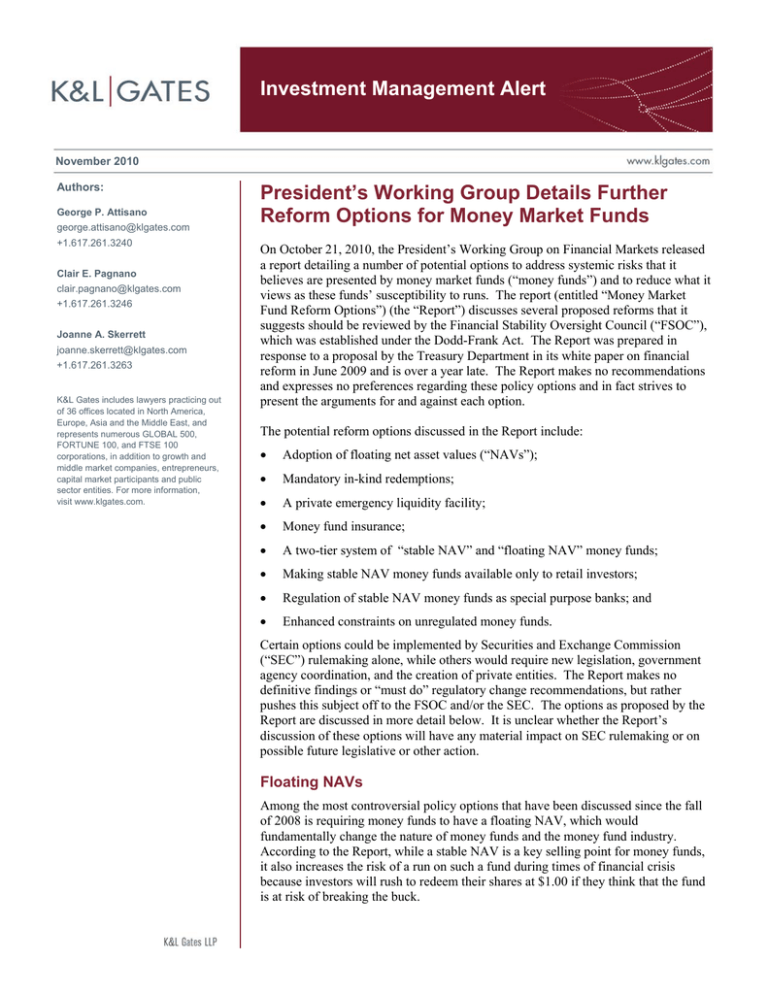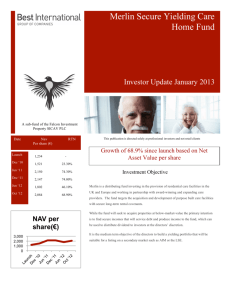
Investment Management Alert
November 2010
Authors:
George P. Attisano
george.attisano@klgates.com
+1.617.261.3240
Clair E. Pagnano
clair.pagnano@klgates.com
+1.617.261.3246
Joanne A. Skerrett
joanne.skerrett@klgates.com
+1.617.261.3263
K&L Gates includes lawyers practicing out
of 36 offices located in North America,
Europe, Asia and the Middle East, and
represents numerous GLOBAL 500,
FORTUNE 100, and FTSE 100
corporations, in addition to growth and
middle market companies, entrepreneurs,
capital market participants and public
sector entities. For more information,
visit www.klgates.com.
President’s Working Group Details Further
Reform Options for Money Market Funds
On October 21, 2010, the President’s Working Group on Financial Markets released
a report detailing a number of potential options to address systemic risks that it
believes are presented by money market funds (“money funds”) and to reduce what it
views as these funds’ susceptibility to runs. The report (entitled “Money Market
Fund Reform Options”) (the “Report”) discusses several proposed reforms that it
suggests should be reviewed by the Financial Stability Oversight Council (“FSOC”),
which was established under the Dodd-Frank Act. The Report was prepared in
response to a proposal by the Treasury Department in its white paper on financial
reform in June 2009 and is over a year late. The Report makes no recommendations
and expresses no preferences regarding these policy options and in fact strives to
present the arguments for and against each option.
The potential reform options discussed in the Report include:
•
Adoption of floating net asset values (“NAVs”);
•
Mandatory in-kind redemptions;
•
A private emergency liquidity facility;
•
Money fund insurance;
•
A two-tier system of “stable NAV” and “floating NAV” money funds;
•
Making stable NAV money funds available only to retail investors;
•
Regulation of stable NAV money funds as special purpose banks; and
•
Enhanced constraints on unregulated money funds.
Certain options could be implemented by Securities and Exchange Commission
(“SEC”) rulemaking alone, while others would require new legislation, government
agency coordination, and the creation of private entities. The Report makes no
definitive findings or “must do” regulatory change recommendations, but rather
pushes this subject off to the FSOC and/or the SEC. The options as proposed by the
Report are discussed in more detail below. It is unclear whether the Report’s
discussion of these options will have any material impact on SEC rulemaking or on
possible future legislative or other action.
Floating NAVs
Among the most controversial policy options that have been discussed since the fall
of 2008 is requiring money funds to have a floating NAV, which would
fundamentally change the nature of money funds and the money fund industry.
According to the Report, while a stable NAV is a key selling point for money funds,
it also increases the risk of a run on such a fund during times of financial crisis
because investors will rush to redeem their shares at $1.00 if they think that the fund
is at risk of breaking the buck.
Investment Management Alert
In using a floating NAV, rather than valuing
portfolio assets at amortized cost, money funds, like
other mutual funds, would value their assets using
market quotations and would not be able to round
their NAVs to $1.00.
The Report discusses several advantages of a
floating NAV, including:
•
A floating NAV would reduce investor
incentives to redeem shares from distressed
funds and increase investors’ tolerance for NAV
fluctuations.
•
Since money fund shares are redeemed at NAVs
set after redemption orders are received, a
floating NAV fund’s losses would be borne on a
pro rata basis by all shareholders, whether they
redeem or not, thereby eliminating or reducing
arbitrage opportunities and some of the
incentives to redeem when a money fund has
experienced a loss.
Private emergency liquidity facility
The Report notes that policymakers have long
recognized the utility of liquidity backstops for
institutions, such as banks, that engage in maturity
transformation (i.e., borrowing shorter term then
lending or investing in order to capture the
difference between shorter and longer term rates).
An adequately capitalized and financed private
facility could provide liquidity to funds that most
need it at times of market stress. Depending on its
structure, such a private facility might have access
to broader liquidity backstops. The Report
describes a number of benefits that could be
provided by establishing a private emergency
liquidity facility:
•
Along with new liquidity requirements in the
revisions adopted earlier this year to Rule 2a-7
under the Investment Company Act of 1940, as
amended (the “1940 Act”), a private facility
could bolster money funds’ ability to withstand
redemptions without selling assets into
potentially illiquid markets during a crisis.
•
There would be efficiency gains from risk
pooling by providing liquidity to the money
funds that need it.
•
A private liquidity facility might provide funds
with flexibility in managing liquidity risks if,
for example, regulators allowed money funds
some relief in liquidity requirements in return
for the funds’ purchase of greater access to the
liquidity facility’s capacity.
•
A private liquidity facility could internalize the
cost of liquidity protection for the money fund
industry and provide appropriate incentives for
investors. Such a facility, if well designed,
would not help funds that take on excessive
capital risks or face runs because of isolated
credit losses.
The Report also points out possible disadvantages:
•
•
•
•
A floating NAV could reduce money funds’
appeal to investors, which could lead to fewer
assets invested in money funds and thus less
capacity to provide short-term credit. The
Report observes that institutional investors
could shift assets to offshore, less regulated or
unregulated money fund substitutes.
A floating NAV might not prevent runs but
rather could result in increased investor
redemptions, if investors respond negatively
when money fund NAVs fluctuate more
frequently.
Risk management might deteriorate without the
discipline required to maintain a $1.00 share
price. With a floating NAV, funds would not
have as clear a tipping point, so fund advisers
might face reduced incentives for prudent risk
management.
The transition from a stable NAV to a floating
NAV industry may be systemically risky and
could cause preemptive redemptions.
The Report also notes that there could be a number
of challenges in establishing a private liquidity
facility:
•
If participation was not mandatory, nonparticipants would free-ride on the industrywide benefits of the facility, and if participation
was mandatory, regulatory oversight of the
facility would be necessary.
November 2010
2
Investment Management Alert
•
The facility could have inadequate capacity to
handle moments of crisis, and its effectiveness
during a crisis could be impeded by conflicts
between the interests of participating money
funds and the facility’s shareholders, who might
want to limit or restrict liquidity provision.
•
The facility could create moral hazard by
diminishing the incentives for money fund
managers to maintain liquidity in the funds’
portfolios.
•
A liquidity facility would do little or nothing to
help a fund that had already experienced a
capital loss.
The insurance option presents a number of practical
and policy considerations, including:
•
historical difficulties in fairly pricing and
successfully guaranteeing rare but high-cost
financial events;
•
the need for new government oversight of
money funds similar to that provided to insured
banks, and a mechanism for setting appropriate
risk-based premiums;
•
the regulatory and economic implications of
such government responsibilities;
•
the shifting of incentives for prudent money
fund risk management to insurers away from
fund advisers; and
•
appropriate limits on insurance coverage in
order to avoid giving money funds an advantage
over banks and to preserve incentives for large
investors to monitor money fund risk
management practices.
Mandatory redemptions in kind
The Report notes that requiring money funds to
satisfy large redemption requests in kind could force
redeeming shareholders to bear their own liquidity
costs, thus reducing their incentive to redeem and
minimizing the transaction costs and reduced
liquidity that would be imposed on other
shareholders. Redemptions in kind present a
number of challenges, however, including:
•
•
Redeeming shareholders with immediate
liquidity needs would have to sell those assets,
with consequences for short-term credit markets
similar to those that would result if the fund
itself had sold the securities.
Since the transfer of money fund portfolio
holdings may be restricted, delivery of an exact
pro rata portion of each portfolio holding to
redeeming shareholders may be impracticable,
introducing allocation issues into the redemption
process.
Money fund insurance
Noting that the Treasury’s Temporary Guarantee
Program helped to slow the run on money funds in
2008, the Report discusses a permanent government
insurance program for money fund shareholders.
The Report contrasts the effects of private liquidity
facilities and insurance, noting that unlike a liquidity
facility, insurance would substantially reduce or
eliminate any losses borne by the fund’s
shareholders and decrease their incentive to redeem
fund shares and thereby set off a run.
A two-tier system with enhanced
protections for stable NAV money
funds
The Report also discusses a two-tier system that
would allow investors (based on their risk tolerance)
to choose between two types of money funds, both
regulated under Rule 2a-7, “stable NAV” funds and
“floating NAV” funds. Stable NAV money funds
would continue to maintain stable, rounded NAVs,
but would be subject to enhanced protections, which
might include tighter regulation and required access
to an external liquidity backstop. Floating NAV
funds would face restrictions less stringent than
those imposed on stable NAV funds, enabling
floating NAV funds to bear greater credit and
liquidity risks. Floating NAV funds would not be
required to obtain access to external sources of
liquidity or insurance, and most likely would pay
higher yields than their stable NAV counterparts.
According to the Report, there are several benefits
to such a system:
•
A two-tier system could mitigate the systemic
risks that arise from a stable, rounded NAV by
requiring stable NAV funds to have additional
November 2010
3
Investment Management Alert
protections that directly address their
vulnerability to runs.
•
The loss of some of the advantages of allowing
institutional investors to choose between stable
NAV money funds and floating NAV money
funds (discussed above).
•
Preserving stable NAV funds would mitigate the
risks of a wholesale shift to floating NAV funds.
•
Frequent changes in a floating NAV fund’s
share price would help align investor
perceptions and actual fund risks, and would
have reduced incentives to redeem early in a
crisis. Investors in floating NAV funds
presumably would be less risk-averse and more
tolerant of NAV changes than stable NAV fund
shareholders.
Regulation of stable NAV money
funds as special purpose banks
During a crisis, investors could shift assets from
riskier floating NAV money funds to stable
NAV money funds, which would presumably be
safer because of their enhanced protections.
•
Money funds would have a broad regulatory
framework similar to existing regulatory
systems that are designed for mitigation of
systemic risk.
•
Money funds might benefit from access to
government insurance and emergency liquidity
facilities at a price similar to that currently paid
by depository institutions.
•
The existence of explicit capital buffers, access
to a liquidity backstop, and deposit insurance
might substantially reduce the uncertainties and
systemic risks associated with money fund
sponsors’ current practice of discretionary
capital support.
•
The Report notes that a two-tier system would face
the same challenges associated with creating a
private liquidity facility (outlined above).
Two-tier system with stable NAV funds
reserved for retail investors
The Report discusses as a policy option making both
stable NAV and floating NAV funds available to
retail investors, while restricting institutional
investors to floating NAV funds. Noting that the
September 2008 run on money funds was primarily
a flight by institutional investors, the Report states
that this approach could protect the interests of retail
investors by reducing the likelihood that a run
beginning in institutional money funds could spread
to retail funds. This approach could be
accomplished with SEC rulemaking without
establishing additional market structures.
The Report notes, however, that the SEC could face
hurdles in defining the two investor classes.
Additional disadvantages of this regime include:
•
Large shifts in assets to money funds substitutes.
For instance, if many institutional investors are
unwilling to switch to floating NAV funds, a
prohibition on sales of stable NAV money funds
shares to such investors may have many of the
same unintended consequences as a requirement
that all money funds adopt floating NAVs.
The Report states that similarities between money
fund shares and bank deposits, including the risk of
runs on both, provide a rationale for regulating
stable NAV funds as special purpose banks. Under
such a regulatory scheme, money funds could see
several benefits:
The Report states, however, that the capital needed
to reorganize money funds as special purpose banks
may be a significant hurdle to successful
implementation of this option. An additional hurdle
would be the substantial increase in explicit
government guarantees that would result from the
creation of new insured deposits. The potential
liability to the government might far exceed any
premiums that could be collected for some time.
Enhanced constraints on unregulated
money fund substitutes
The Report notes that new restrictions on registered
money funds might reduce the appeal of such funds
and lead investors to shift assets to unregulated
money funds. Because unregulated funds often seek
to maintain a stable NAV and have other features
making them vulnerable to runs, the Report states
that such funds also are likely to pose systemic
November 2010
4
Investment Management Alert
risks. The Report discusses policy reforms to
address these risks, such as excluding unregulated
stable NAV funds from the registration exemptions
in the 1940 Act’s private fund provisions; these
options likely would require both legislative and
regulatory action. The Report also notes that
banking and state insurance regulators could
consider restrictions to mitigate systemic risk for
bank common and collective funds and other stable
NAV investment pools that are exempt from 1940
Act registration.
*
*
*
According to the Report, the SEC will, in the near
future, solicit public comments on the options
discussed in the Report. Following a comment
period, a series of meetings will be held in
Washington, D.C., with various interested persons,
experts and regulators.
Anchorage Austin Beijing Berlin Boston Charlotte Chicago Dallas Dubai Fort Worth Frankfurt Harrisburg Hong Kong London
Los Angeles Miami Moscow Newark New York Orange County Palo Alto Paris Pittsburgh Portland Raleigh Research Triangle Park
San Diego San Francisco Seattle Shanghai Singapore Spokane/Coeur d’Alene Taipei Tokyo Warsaw
Washington, D.C.
K&L Gates includes lawyers practicing out of 36 offices located in North America, Europe, Asia and the Middle East, and represents numerous
GLOBAL 500, FORTUNE 100, and FTSE 100 corporations, in addition to growth and middle market companies, entrepreneurs, capital market
participants and public sector entities. For more information, visit www.klgates.com.
K&L Gates comprises multiple affiliated entities: a limited liability partnership with the full name K&L Gates LLP qualified in Delaware and
maintaining offices throughout the United States, in Berlin and Frankfurt, Germany, in Beijing (K&L Gates LLP Beijing Representative Office), in
Dubai, U.A.E., in Shanghai (K&L Gates LLP Shanghai Representative Office), in Tokyo, and in Singapore; a limited liability partnership (also named
K&L Gates LLP) incorporated in England and maintaining offices in London and Paris; a Taiwan general partnership (K&L Gates) maintaining an
office in Taipei; a Hong Kong general partnership (K&L Gates, Solicitors) maintaining an office in Hong Kong; a Polish limited partnership (K&L
Gates Jamka sp.k.) maintaining an office in Warsaw; and a Delaware limited liability company (K&L Gates Holdings, LLC) maintaining an office in
Moscow. K&L Gates maintains appropriate registrations in the jurisdictions in which its offices are located. A list of the partners or members in each
entity is available for inspection at any K&L Gates office.
This publication is for informational purposes and does not contain or convey legal advice. The information herein should not be used or relied upon
in regard to any particular facts or circumstances without first consulting a lawyer.
©2010 K&L Gates LLP. All Rights Reserved.
November 2010
5


